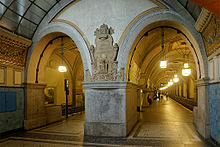
The Berlin U-Bahn is a rapid transit system in Berlin, the capital and largest city of Germany, and a major part of the city's public transport system. Together with the S-Bahn, a network of suburban train lines, and a tram network that operates mostly in the eastern parts of the city, it serves as the main means of transport in the capital.

U1 is a line on the Berlin U-Bahn, which is 8.8 kilometres (5.5 mi) long and has 13 stations. Its traditional line designation was BII. It runs east–west and its eastern terminus is Warschauer Straße S-Bahn station where it connects to the Schlesische Bahn. From there it runs through Kreuzberg via Gleisdreieck and Wittenbergplatz on to the Kurfürstendamm.

U2 is a line of the Berlin U-Bahn. The U2 line starts at Pankow S-Bahn station, runs through the eastern city centre (Alexanderplatz) to Potsdamer Platz, the western city centre and finally to the Ruhleben terminal station.

U8 is a line on the Berlin U-Bahn. It has 24 stations and is 18.1 km (11.2 mi) long. The U8 is one of three north–south Berlin U-Bahn lines, and runs from Wittenau to Neukölln via Gesundbrunnen. The original proposal was for a suspended monorail like the Wuppertal Schwebebahn.

U9 is a line on the Berlin U-Bahn. The line was opened on 28 August 1961 as Line G.

U3 is a line on the Berlin U-Bahn created in its current version on 7 May 2018.

Friedenau is a locality (Ortsteil) within the borough (Bezirk) of Tempelhof-Schöneberg in Berlin, Germany. Relatively small by area, its population density is the highest in the city.

Spichernstraße is a Berlin U-Bahn station located on the U3 and the U9 lines, located in Wilmersdorf neighbourhood. The U3 portion opened on 2 June 1959, replacing the nearby Nürnberger Platz station, which was closed and dismantled. The U9 portion, which lies deeper underground, opened on 28 August 1961 as the southern terminus of the new line, then called G. The eponymous street is named after Spicheren in Lorraine, France, site of the 1870 Battle of Spicheren.

Hohenzollernplatz is a Berlin U-Bahn station located in the Wilmersdorf district on the U3 line.

Fehrbelliner Platz is a station of the Berlin U-Bahn located in the Wilmersdorf district on the U3 and the U7 lines.

Rüdesheimer Platz is a Berlin U-Bahn station located in the Wilmersdorf district on the U3 line.

Breitenbachplatz is a Berlin U-Bahn station located in the Dahlem district on the U3.

Berlin Innsbrucker Platz is a railway station in the Schöneberg district of Berlin and located on the square of the same name. It is served by the Ringbahn lines S41, S42 and S46 of the Berlin S-Bahn. It is also the terminus of the U-Bahn line U4.

Berlin Gesundbrunnen station is a railway station in Berlin, Germany. It is situated in the Gesundbrunnen district, part of the central Mitte borough, as an interconnection point between the northern Ringbahn and Nord-Süd Tunnel lines of the Berlin S-Bahn, as well as a regional and long distance station of the Deutsche Bahn network. The station is operated by the DB Station&Service subsidiary of Deutsche Bahn AG and is classified as a Category 1 station, one of 21 in Germany and four in Berlin, the others being Berlin Hauptbahnhof, Berlin Südkreuz and Berlin Ostbahnhof.

Halensee is a station on the Berlin Ringbahn in the Halensee district of Berlin. It is served by the S-Bahn lines S41, S42 and S46.

Bundesautobahn 100 is an Autobahn in Germany.

The North–South S-Bahn Tunnel is the central section of the North–South transversal Berlin S-Bahn connection crossing the city centre. It is not to be confused with the Tunnel Nord-Süd-Fernbahn, the central tunnel part of the North–South main line used by intercity and regional trains. The S-Bahn North–South line encompasses the route from Bornholmer Straße and Gesundbrunnen via Friedrichstraße and Anhalter Bahnhof to Papestraße and Schöneberg.

Schmargendorf is a south-western locality (Ortsteil) of Berlin in the district (Bezirk) of Charlottenburg-Wilmersdorf. Until 2001 it was part of the former district of Wilmersdorf.

The Berlin U-Bahn originated in 1880 with Werner Siemens' idea to build an urban railway in Berlin. During the nine years after the German Empire was founded, the city's population grew by over one-third and traffic problems increased. In 1896, Siemens & Halske began to construct the first stretch of overhead railway. On 1 April 1897, the company began construction of an electric underground railway. The Berliner Verkehrs Aktiengesellschaft (BVG) was formed in 1928, and took over further construction and operation of the network. In 1938, the company was renamed Berlin Transport Company; the original acronym, however, remained. Since 1994, the BVG has been a public company.
Wilhelm Leitgebel was a German architect who is celebrated for his designs of five Berlin U-Bahn stations. Leitgebel is perhaps best known for his work on the Heidelberger Platz station in Berlin, completed in November 1913. Leitgebel also worked with Alfred Grenander on Nürnberger Platz.
























